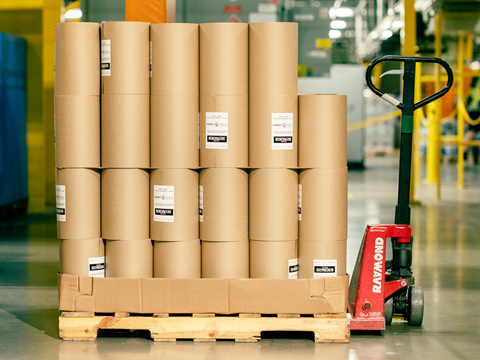
95% of the plastic air pillows used in Amazon’s North American delivery packaging have been replaced with paper filler, the company claims, with a complete phase-out expected by the end of the year.
Amazon states its aims to prioritize recyclable materials and use as little packaging as possible to avoid waste without compromising the safety of the product in transit. Apparently, its current efforts will avoid nearly 15 billion plastic air pillows every year and contribute to the company’s goal of removing plastic delivery packaging from its North American fulfilment centres.
The company’s first automated fulfilment centre in the USA was announced last October. There it had swapped plastic air pillows with paper filler, and the company was able to test the feasibility of this solution and, eventually, implement it into all its North American packaging.
In order to make the transition, Amazon’s teams collaborated with suppliers and sourced paper that, according to the company, is made from 100% recycled content. This was coordinated across other fulfilment centres, with the company aiding employees in changing machinery and hosting employee trainings for the new systems and machines.
The paper filler was tested by Amazon, including an assessment by a third-party engineer lab. According to the results, it provides “the same, if not better” product protection than plastic air pillows; it is also thought to contain 100% recycled content and be recyclable at kerbside, meaning consumers can dispose of their packaging via household recycling streams.
“I’m proud of the cross-Amazon collaboration to make a positive impact on the customer delivery experience with easier to recycle materials,” said Pat Lindner, VP of Mechatronics and Sustainable Packaging. “It’s a great example of how we thoughtfully test and scale new solutions to protect our customer experience.
“We are working towards full removal in North America by end of year and will continue to innovate, test, and scale in order to prioritize kerbside recyclable materials.”
“I’m so excited we’re changing over to paper,” added Christian Garcia, fulfilment Associate at the BFL1 fulfilment centre in Bakersfield, California. “It’s not only easier to work with, but the machinery gives us more space so it’s easier to pack orders. And I’m proud to be a part of a change that allows customers to recycle at home.”
Amazon believes that, in 2022, 11% of its packages shipped globally were not delivered in additional packaging thanks to its Ships in Product Packaging programme. We recently spoke to the programme’s global lead, Kayla Fenton, to learn more about the ideas behind the project, the ins-and-outs of the process, and where it is expected to go in the future.
Another reported outcome of the programme is that one in two of the retailer’s European shipments are now delivered without additional box packaging. Over 50% are now said to arrive in reduced, recyclable deliver packaging like paper bags and cardboard envelopes, if any extra packaging is applied at all.
In other news, Flöter Verpackungs-Service GmbH received a WorldStar Packaging Award under the e-commerce category for its PaperWave Bio paper air cushions, which are FSC-certified biodegradable and made from 100% recycled paper.
The company’s PaperWave box would go on to be nominated for a Sustainability Award last year, falling under the commercialised E-commerce category. According to the company, the company claims it reduces the cushioning material inside the box by 40%.
If you liked this story, you might also enjoy:
How are the top brands progressing on packaging sustainability?
The ultimate guide to global plastic sustainability regulation











No comments yet